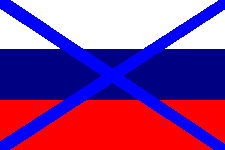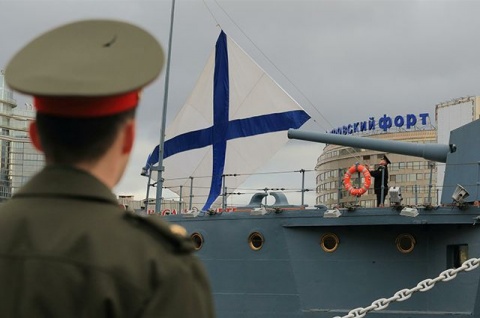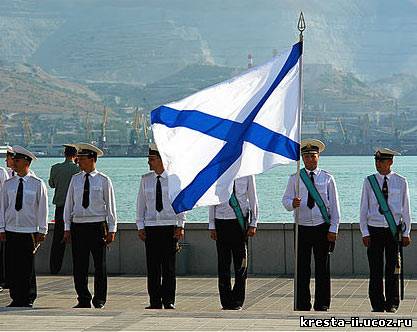Which flag is green white black. Andreevsky flag

It is connected with the construction of the first Russian warship "Eagle" in 1669. According to the surviving evidence for the "Eagle" in 1668, a flag was made consisting of white, blue and red (and for the production of the flag an equal amount of fabric of each color was required), the exact arrangement of the colors is not known, the flag was ordered to "write" Russian National emblem... There are several reconstructions of this flag. According to one of the reconstructions (by P.I.Belavenets), the Eagle flag was divided by a blue cross into 2 red and 2 white fields according to the Strelets pattern (similar flags are depicted on the engraving of Adrian Shkhonebek “The Siege of Azov in 1696” (about 1700). A similar flag, along with other variants, is depicted in one of the first books about the flags of the Dutchman Karl Alyard (1695). The date of publication of the book Alyard (1695) should not confuse the reader, at that time the books were printed for a very long time, and corrections and additions were made during the printing process In reality, this version of the flag could appear in the book no earlier than 1698.
Other historians believed that already on the "Eagle" there was a flag of three horizontal stripes: white, blue and red. Probably the first to express this idea was the historian of the fleet F.F. Veselago
Peter I, carried away by the idea of creating Russian fleet, he himself studied maritime business, he walked on a boat on the Pereyaslavskoye lake, the Prosyan pond in Izmailovo. Today the boat of Peter I is kept in the Navy Museum. On the surviving engravings, the boat is depicted with the imperial standard on the mast and the flag of the admiral-general at the stern.
According to the historian P.I.Belavenets, on August 6, 1693 in Arkhangelsk, on an armed yacht "St. Peter", Peter I used a striped white-blue-red "Tsar of Moscow flag" with a golden double-headed eagle in the middle lane. In the book of flags by Karlus Alyard, this flag was described as follows:
"The flag of His Tsarist Majesty of Moscow is divided into three, the upper stripe is white, the middle is blue, the lower one is red. On the blue stripe of gold with a royal karuna, there is a double-headed eagle with a red stamp in its heart, with a silver St. George without a snake."
Now this flag is kept in the Maritime Museum of St. Petersburg. He got there from Arkhangelsk, where he stayed for many years, being donated by Peter I to Archbishop Athanasius of Arkhangelsk.
Some historians are inclined to believe that the white-blue-red flag was borrowed by Peter from Holland (the Dutch flag is almost the same, only the order of the stripes is different). Maybe it is so. But, as we can see, the use of white, blue and red colors on the flag was recorded even during the reign of Tsar Alexei Mikhailovich, Peter's father, long before the West European voyage of Peter Alexeevich. The "Dutch" version is also connected with the head of the "Eagle" construction, the Dutch captain O. Butler. He is credited with the idea of making the flag of the Russian ship modeled on the flags of his homeland.
In 1695, Peter I began a war with Turkey. This served as a powerful impetus for the creation of a military fleet. Many warships were built. Russian sailors entered the Black and then the Baltic Sea.
In 1697, Peter I established a new model naval flag Russia, which consisted of horizontal white, blue, red stripes. In October-November 1699, the first variants of the Andreev flag appeared. In 1699, when the ship "Fortress" sailed to Constantinople, Peter I, in instructions to the Russian envoy Emelyan Ukraintsev, drew a three-sheet flag with an oblique cross crossing it.
Peter I especially emphasized that the Andreev flag was chosen by him in honor of St. Andrew the First-Called "for the sake of the fact that Russia received holy baptism from this apostle." In addition, the Andreev flag, according to the thought of Peter I, showed that Russia has access to four seas. It is very likely that Peter's choice was influenced by the flag of Scotland he saw in Europe (blue with a white St. Andrew's cross). Saint Andrew was considered the patron saint of Scotland long before the introduction of his cult in Russia. The Scottish Order of St. Andrew is known. Peter copied the order and may have decided to transfer the St.Andrew's flag to Russian soil, only changing its colors.



On engravings depicting ships of that time, one can see various options for transitional types of naval flags(some of them are probably true, some are most likely an erroneous reconstruction of the engraver). For example, in the engraving depicting the ship "Predistination", flags of 9 horizontal stripes are depicted on the bow, topmast and stern; white, blue and red (a similar practice was widespread in Holland). The frigate "Dumkart" is depicted with a "hybrid" flag - the St. Andrew's cross is framed above and below by stripes of national colors.
 The engraving depicting "Poltava" flies at the stern of the ship White flag with the St. Andrew's cross, not reaching the ends of the corners of the flag, on the topmast - the imperial standard. However, the engraving of "Poltava" raises certain criticism. The fact is that on the bow of the ship there is a red flag with the St.Andrew's cross in the canton, and on the stern there is a flag with an St. This practice is highly questionable. In the Russian fleet, the jack (bow flag) first repeated the stern flag, and then a single jack was introduced. If there is a "colored" flag on the bow, then there must be one at the stern as well. Apparently the author of the engraving somewhat "approximated" the information he had.
The engraving depicting "Poltava" flies at the stern of the ship White flag with the St. Andrew's cross, not reaching the ends of the corners of the flag, on the topmast - the imperial standard. However, the engraving of "Poltava" raises certain criticism. The fact is that on the bow of the ship there is a red flag with the St.Andrew's cross in the canton, and on the stern there is a flag with an St. This practice is highly questionable. In the Russian fleet, the jack (bow flag) first repeated the stern flag, and then a single jack was introduced. If there is a "colored" flag on the bow, then there must be one at the stern as well. Apparently the author of the engraving somewhat "approximated" the information he had.
This page uses materials from the book by A.N.Basov "History of naval flags", the book by V.A.Sokolov "Vexillological reference book on flags Russian Empire and the USSR ", as well as letters of AN Basov.
The navy itself appeared in Russia only under Peter I. Naval flags, apparently, appeared on the training flotilla of Peter I on Lake Pereyaslavl. As you know, Peter's passion for navigation began with an old English boat he found in Nikolai Romanov's barn. The repaired boat was tested by the tsar on the Yauza and Prosyan pond in the village of Izmailovo, but they seemed too cramped for him. After that, Peter transported the boat to Lake Pereyaslavskoye, where several "small" frigates and yachts were also made under the guidance of master Karsten Brant and other foreign craftsmen. The construction of the Pereyavlavl flotilla was completed in 1692.
However, no objective information about the flags on Peter's boat and on the ships of the Pereyaslav flotilla has been preserved. About their appearance(and even about the very existence of such flags) we can only guess ...
In 1693, Peter I, with several ships, embarked on a voyage along the Northern Dvina and the White Sea. Peter's yacht already had a white-blue-red striped flag with an eagle on it.
The next milestone in the history of the military fleet was the Azov fleet, which began to be built in the 1690s. In the History of the Russian Fleet, describing the campaign of the galleys of the Azov fleet of Peter I (1696), S. Elagin wrote the following about the flags: “The colors white, blue and red ... ships of the Azov fleet. Actually the name of the flag, although it is found occasionally in the descriptive books, has not yet been adopted. books and documents of that time. In the course, the flag was worn on the upper edge of the main yard; at anchor, or in the case of retraction of the masts ... he probably climbed on the stern flagpole. The expression "raising the flag" did not exist: the "flag", whether it was a stern flag or a signal one, was "put up" and "lowered". It is not known whether there was a difference for the flagships, from the described books it is only clear that the Lefort gallery had a golden-headed flag with an eagle. On the vice-admiral's gallery there is a banner on the foremast, a badge on the mainmast, a pennant on the mainmast, and another pennant on the foremast. "
Quote from "History of the Russian Fleet" by S. Elagin, St. Petersburg, 1864, ch. 1.c. 40.
The appearance of the first naval flag of Russia is associated with the construction of the first Russian warship "Eagle" in 1669. According to the surviving evidence for the "Eagle" in 1668, a flag was made consisting of white, blue and red colors (and the production of the flag required an equal amount of fabric of each color), the exact arrangement of the colors is not known, the flag was ordered to "write" Russian state emblem (decree of Alexei Mikhailovich of April 24, 1669).
I - Cross flag. P. Belavenets's version
There are several reconstructions of this flag. According to one of the reconstructions (by P.I.Belavenets), the Eagle flag was divided by a blue cross into 2 red and 2 white fields according to the Strelets pattern
Godbrothers Scots
The St. Andrew's flag, which became a symbol of the victories of the Russian navy, like many other innovations, appeared in Russia during the time of Peter I.
The first ever state flag with the so-called St. Andrew's cross appeared in Scotland.
The Apostle Andrew the First-Called was martyred on an oblique cross. According to legend, in 832, King Angus II, who led the army of the Picts and Scots, before the battle with the Angles led by thelstan, prayed to God on the night before the battle for victory on the battlefield and made a vow that in case of victory he would declare the holy Apostle Andrew the First-Called patron saint of Scotland. In the morning, the clouds over the battlefield formed the letter "X" in the blue sky, repeating the shape of the cross on which the Apostle Andrew was crucified. The inspired Scots and Picts defeated the enemy, after which Andrew the First-Called was proclaimed the patron saint of Scotland. The flag of the country has become a white oblique cross on a blue background.
After the personal union of England and Scotland in 1606, the Scottish oblique cross became part of the common flag of the United Kingdom and is present in it to this day.

The fleet acquired a flag in honor of the patron saint of Russia
When, at the turn of the 17th-18th centuries, Peter I began to think about the new state symbols, the oblique cross was among the most preferred symbols.
According to legend, the Apostle Andrew visited the lands of the future Rus, therefore, starting from the XI century in the Russian lands, he was a particularly revered saint - the heavenly patron of Russia.
In 1698, Peter I established the first order in Russia, which was the highest award Russian Empire, - the Order of the Holy Apostle Andrew the First-Called. It is not surprising that among the designs of flags drawn by the tsar himself, there was also a flag with an oblique cross.
On December 11, 1699, Peter I approved the flag with a blue oblique cross on a white background as one of the flags adopted for use in the Russian fleet. In fact, the tsar continued to refine the flag and status for two more decades, and only the Ship Charter of 1720 established: "The flag is white, across it there is a blue St. Andrew's cross, with which he christened Russia."
"God and St. Andrew's flag are with us!"
From that moment until 1917, the Andreevsky flag became the main and only one in the Russian Navy. In 1819, it was supplemented by the St. George admiral's flag, which was the St. Andrew's flag, in the center of which was placed a red heraldic shield with the canonical image Saint George the Victorious... A similar flag was awarded to a ship whose crew showed exceptional courage and courage in achieving victory or in defending the honor of the naval flag.
Initially, the length of the Andreevsky flag reached four meters. The gigantic size was needed in order for the banner fluttering in the wind to create a terrifying roar - it was a kind of psychic attack.
The veneration of the Andreevsky flag in the fleet was extremely great. The commanders of the Russian ships, entering the battle, invariably repeated the same phrase: "God and the St. Andrew's flag are with us."
The ship that lowered the flag was burned, the captain was forbidden to marry

The ship charter of Peter I, which ordered to protect the St.Andrew's flag to the last drop of blood, was sacredly observed. In the entire history of the Russian fleet, the flag was voluntarily lowered only twice.
On May 11, 1829, the commander of the Russian frigate "Raphael" Captain 2nd Rank Semyon Stroynikov lowered the flag in front of the Turkish squadron of 15 ships, trying to save the life of the crew.
By a personal decree of Emperor Nicholas I, it was ordered that the disgraced frigate should be burned if it fell into the hands of the Russians. It happened only 24 years later, in the Battle of Sinop, but the will of the emperor was carried out - "Raphael", who was in the Turkish fleet, was burned, and this name was never used for Russian ships.
As for Captain Stroynikov, upon his return from captivity, he was stripped of all awards and titles, and was also demoted to ordinary sailors. Moreover, Stroynikov was forbidden to marry, "so as not to have the offspring of a coward and a traitor in Russia." The paradox, however, was that the disgraced captain already had two sons by that time, and both of them later became rear admirals of the Russian fleet.
The second time the flags on Russian ships were lowered in 1905, at the end of the Tsushima battle, by order of Rear Admiral Nebogatov, who sought to save the lives of the remaining sailors and officers.
In August 1905, for this act, he was stripped of his ranks, and then brought to trial, which in December 1906 sentenced the rear admiral to death, commuted to 10 years in a fortress. Nebogatov served 25 months, after which he was pardoned.

Return
The flag of the Russian Navy and St. Andrew's flag ceased to be in 1917. The last Andreevskie flags on Russian ships were lowered in 1924 in the port of Bizerte in north africa, where the ships of the squadron of the White Army were concentrated.
The darkest page in the history of the St. Andrew's flag was its use as a symbolism by collaborators from the Russian Liberation Army (ROA) of General Vlasov, who fought on the side of the Nazis.
In January 1992, the government of the Russian Federation made a decision to return the St. Andrew's flag to the Russian Navy instead of the flag of the Soviet Navy.
July 26, 1992 at Day Navy on all warships, the flags of the USSR Navy were raised for the last time, after which, to the sound of the USSR anthem, they were  deflated. Instead of them, to the anthem Russian Federation Andreevskie flags were raised.
deflated. Instead of them, to the anthem Russian Federation Andreevskie flags were raised.
The only ship where St. Andrew's flag is not raised to this day is the Soviet submarine S-56, which has become a war memorial. In tribute to the feat of Soviet sailors during the Great Patriotic War on the S-56 there is a daily ceremony of raising and lowering the flag of the USSR Navy, and Russian symbols are not used
- Weapon sounds cs go for 1
- Festival "times and eras"
- Festival of avant-garde music Fields and "Masters of Music"
- Vdnkh: description, history, excursions, exact address Moscow Butterfly House
- After the overhaul, the Kurakina Dacha park was opened with the excavated Kozlov stream
- Library of Foreign Literature named after
- Governing Senate - Constitutional Court of the Russian Federation

 Live Journal
Live Journal Facebook
Facebook Twitter
Twitter